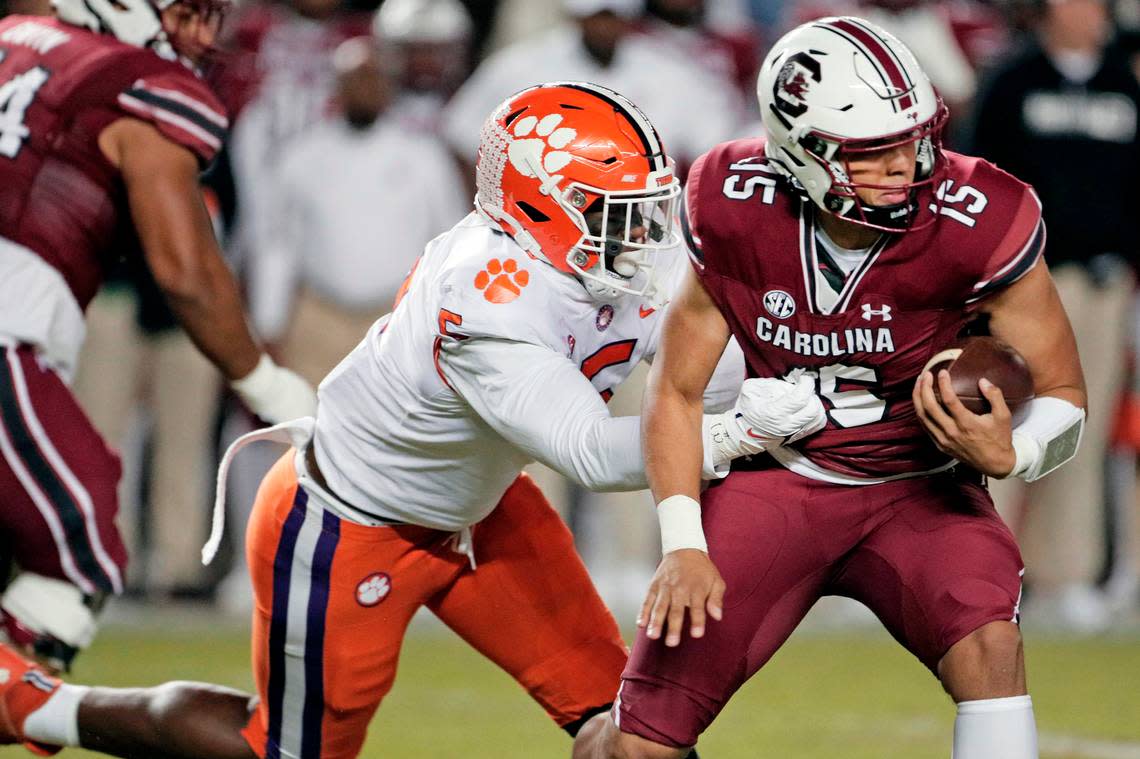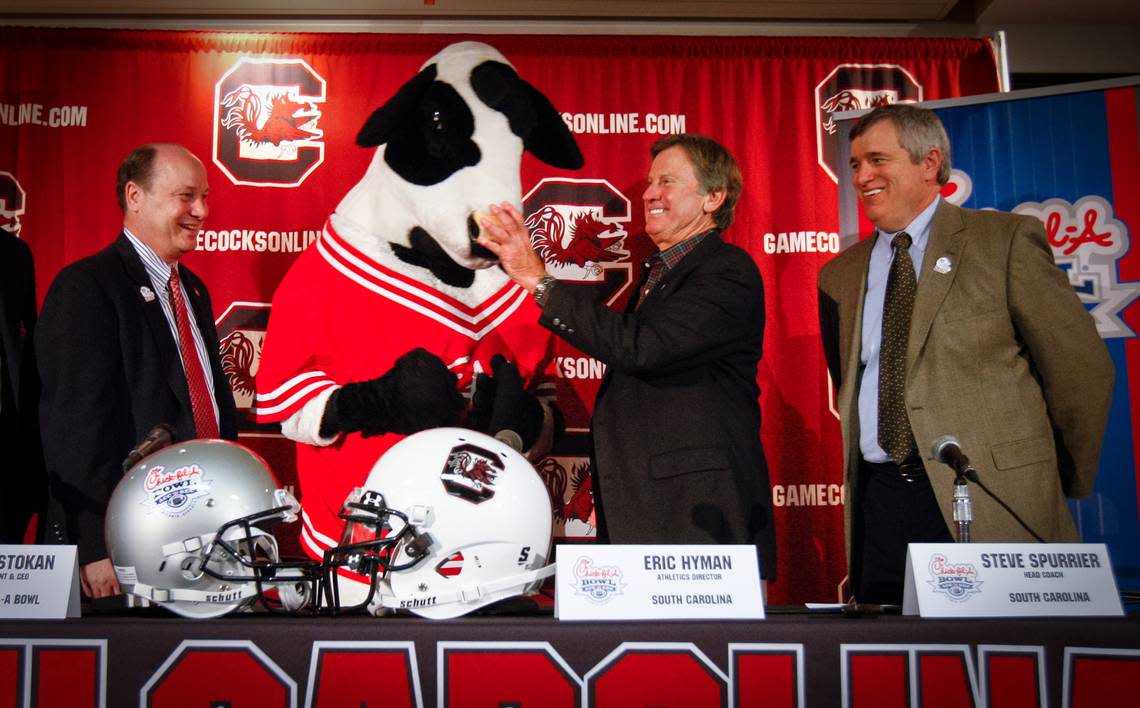Clemson and South Carolina together in SEC? What realignment could mean for rivalry
Georgia didn’t want Georgia Tech. Florida didn’t want Florida State. And Eric Hyman, South Carolina’s athletic director at the time, certainly didn’t want Clemson.
When it came to the SEC’s 2010s realignment cycle, the very idea of Georgia, Florida and USC welcoming their top in-state rivals to their prestigious conference with open arms was a no-go because, as Hyman put it, “we really didn’t want to share.”
“Us three ADs, we had discussions and we wanted to keep what we had,” Hyman, USC’s athletic director from 2005 to 2012, told The State this week. “If we were going to expand, we didn’t really want to expand with those three schools.”
Missouri and Texas A&M ultimately left the Big 12 for the SEC in 2012, an outcome Hyman described as far more “palatable” than propositions mixing Bulldogs with Yellow Jackets, Gators with Seminoles or Gamecocks with Tigers.
A decade later, though, amid college football’s boldest realignment cycle yet, the idea of Clemson and South Carolina sharing future SEC status is a legitimate reality.

Why? Simply put, the SEC’s 2021 acquisition of Big 12 schools Texas and Oklahoma and the Big Ten’s acquisition of Pac-12 schools Southern Cal and UCLA has sent the sport into a TV contract-fueled frenzy.
Schools are reconsidering longtime allegiances, geography is optional and, as college football flirts with an NFL-esque model of two mega-conferences with the SEC and Big Ten serving as NFC and AFC, nobody wants to get left behind.
Though longtime ACC member Clemson has declined to comment on realignment reports, the Tigers were credibly linked to the SEC and Big Ten as a top expansion candidate earlier this month.
Immediate action seems unlikely, considering the SEC is reportedly set (for now) at 16 teams, the ACC’s grant of rights has proven a remarkably strong contract and Notre Dame, perhaps the only more attractive SEC or Big Ten target outside of Clemson, remains in wait-and-see mode.
Still, the Tigers’ reported flirtation begs the question: Could Clemson and South Carolina coexist in the SEC? In times like this, Hyman is glad he’s retired.
“If I was the athletic director, I’d have reservations about doing it,” he said. “But I’m not the athletic director. Times change. Things change. The feeling may be different. It may be something you have to do.”

‘A double whammy’
Clemson-USC is one of the country’s premier college football rivalries. The teams first met in Columbia in 1896, and their Nov. 26 game in Clemson this fall will be matchup No. 119.
That included a streak of 111 consecutive meetings from 1909 to 2019 — the second longest uninterrupted run in the country — before, topically, South Carolina played an SEC-only schedule in 2020 due to coronavirus pandemic-induced changes.
The on-field rivalry also saw its share of conference overlap.
Clemson and South Carolina shared SoCon status from 1933 to 1952. As charter members of the original eight-team ACC, they also shared that conference from 1953 to 1970 until USC’s well-publicized withdrawal.
The past five decades, though, have been defined by memorable nonconference battles with Clemson staying put in the ACC (2023 will be Year 70) and South Carolina competing as an independent (1971-1991) and SEC school (1992-present).
It’s a divide Tommy Bowden appreciated while coaching at Clemson, especially considering his previous stints at Alabama and Auburn. Those programs have competed in the Iron Bowl as SEC West Division counterparts for decades.
Winning that game, Bowden said, “was like double bonus points.”
But losses were doubly crushing: not only a rivalry defeat but a conference defeat that could shake up standings.
Bowden went 7-2 record against South Carolina in his nine seasons at Clemson from 1999 to 2008 and supports the Tigers moving to the SEC over the Big Ten if they ever choose to leave the ACC. But he maintains plenty of reservations about how the rivalry would fare as an SEC affair.
“It would make it worse,” he said. “It used to not hurt you in the conference. If we were trying to win the ACC, that was an insignificant loss. If you’re in the same conference, and it ends up being a conference loss and a rivalry loss? Oh, man …”

Modern history points to such a two-pronged defeat affecting one school far more than the other. Steve Spurrier’s Gamecocks won five consecutive games over Dabo Swinney’s Tigers from 2009 to 2013, setting a school record and making lots of memories in the process, but it’s been all orange and white since then.
Clemson has won seven straight over South Carolina dating back to 2014.
The record-tying streak coincides with the Tigers’ rise to national prominence as an ACC behemoth and College Football Playoff stalwart with six total appearances, four national championship appearances and 2016 and 2018 titles to their name.
Last year’s 30-0 shutout of USC in Columbia gave Clemson its fifth consecutive rivalry win by 21-plus points, the longest series streak by either team, and made Swinney the first coach on either side of the rivalry to win seven in a row.
Clemson also leads the all-time series 72-42-4.
“When South Carolina would lose in the past, they’d say, ‘Oh, we lost to Clemson — but we’re in the SEC,’ ” Bowden said, laughing. “Now it’s, ‘Oh no, we lost to Clemson — and they’re in the SEC.’ It would be a double whammy.”

‘Distinct identities’
Indeed, conference pride would also be at play.
The Gamecocks’ SEC status has long been “the feather in their cap,” Bowden said, something he remembers coming up in plenty of head-to-head recruiting battles.
What if that disappears?
Shehan Jeyarajah, a Texas-based national college football writer for CBS Sports, points to Texas and Texas A&M as a litmus test. The Aggies’ 2012 move from the Big 12 to the SEC made them “probably the biggest realignment winner out of any major conference over the last 10, 15 years,” he said. “They were able to establish this unique identity separate from Texas.”
Down a classic rivalry but free of its pesky “little brother” moniker, Texas A&M football emerged as a reputable national program … only for Texas, along with Oklahoma, to announce its move to the SEC by 2025 last summer.
The Aggies weren’t shy in voicing their public displeasure with the move.
Though Jeyarajah still sees Texas A&M holding its own against Texas in the SEC, he’s certain the program’s ability to “almost lord their success over Texas for the last decade as they’ve built themselves into a power” will be missed.
“All of the sudden, you’re recruiting on the same wavelength again,” he said. “If you’re Texas A&M, you can’t negatively recruit that Texas is in a lesser conference or whatever else.”
Jeyarajah added of potential Clemson-South Carolina SEC matchups: “It’s such an interesting rivalry because you do have that separation, where it gives them an opportunity to have these distinct identities. How does that look when they’re the same identity?”

Hyman, coincidentally, worked as Texas A&M’s athletic director from 2012 to 2016. He agrees with Jeyarajah: Texas joining is far from ideal for an Aggies program that, after “years and years and years” of Texas having the upper hand, had finally tipped the scales in their favor.
“It’s not going to be brutal,” he said, “but it’s going to be more difficult.”
To Hyman, Clemson joining South Carolina in a conference is a “could happen” and not a “will happen.” After all, moving to the SEC isn’t a slam dunk for either side.
For the Tigers, joining the country’s best football conference would, naturally, mean a much tougher path to the CFP and increased travel budgets for other sports (though Big Ten membership would make those budgets even more egregious).
For the SEC, adding Clemson doesn’t establish new footprints or television markets in the same way acquiring, say, a North Carolina or Virginia school would. For the soon-to-be 16 schools in the nation’s richest conference, further additions would only reduce their annual SEC payouts, projected to top $100 million by 2029.
But Clemson and the SEC line up on lots: not just geography and football-centric culture but a proven administrative commitment to facilities and staff salary pools.
And as realignment dominoes continue to fall, it’s a conversation that won’t go away, bringing tricky questions about the state’s long-running rivalry with it.
The State’s Ben Portnoy contributed reporting
